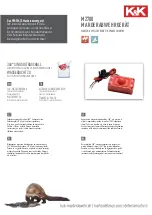
Page 23 / 45
REV. STV20110519
5.
TROUBLESHOOTING
Trouble Description
Possible cause
Remedial action
Manual valve does not
open when actuator is
turned counterclockwise
1. Diaphragm is stuck on valve seat.
2. Diaphragm is not mounted properly
on the actuator.
3. Actuator is not functioning
correctly.
4. Incorrect flow direction in
combination with high fluid pressure.
1. Inspect diaphragm and replace if
required.
2. Correct mounting. Some force must
be used to push the diaphragm onto the
actuator stem.
3. Inspect and replace if required.
4. Correct flow direction or lower fluid
pressure.
Manual valve does not
close when actuator is
turned clockwise
1. Incorrect flow direction in
combination with high fluid pressure.
1. Correct flow direction or lower fluid
pressure.
Pneumatic valve does not
open
1. Diaphragm is stuck on valve seat.
2. Diaphragm is not mounted properly
on the actuator.
3. Actuator is not functioning
correctly.
4. Compressed air supply is too low.
5. Pneumatic hose is damaged.
6. Solenoid valve, if supplied, faulted
or in wrong position.
7. Incorrect flow direction in
combination with high fluid pressure.
1. Inspect diaphragm and replace it if
required.
2. Correct mounting. Some force must be
used to push the diaphragm onto the
actuator stem.
3. Inspect and replace if required.
4. Check compressed air supply pressure.
5. Replace pneumatic hose.
6. Check that the solenoid valve is in the
correct position and operating normally.
Replace solenoid valve if required.
7. Correct flow direction or lower fluid
pressure.
Pneumatic valve does not
close
1. Actuator is not functioning
correctly.
2. Solenoid valve electrical cable, if
supplied, is damaged.
3. Pneumatic system does not
ventilate.
4. Incorrect flow direction in
combination
with high fluid pressure.
1. Inspect and replace if required.
2. Replace electrical cable.
3. Check ventilation of pneumatic system
4. Correct flow direction or lower fluid
pressure.
Cleaning in CIP is not
satisfactorily
1. Cleaning chemicals wrong type or
too low concentration.
2. Flow too low.
3. Valve not installed in drainable
position, refer to figure 10.
4. Flow obstructed.
5. Diaphragm is damaged.
1. Use correct chemicals and
concentration.
2. Increase flow.
3. Check valve orientation and change if
required.
4. Check flow path.
5. Replace diaphragm.
Rouging or similar effects
on inner surface
1. No acid used in CIP.
2. Poor WFI or PW quality.
3. Incorrect chemicals used in CIP.
1. Perform passivation regularly.
2. Check quality of WFI and PW.
3. Use compatible chemicals to valve
housing material.
Diaphragm has short
lifespan
1. Incorrect diaphragm material for the
application.
2. Media has too high temperature.
1. Check material compatibility.
2. Lower temperature or use alternate
material.
Telltale hole is leaking
1. Diaphragm is damaged.
1. Replace diaphragm.
Valve is leaking
1. Clamp is not properly mounted.
2. Diaphragm is damaged.
3. Fluid pressure is too high.
1. Mount clamp or replace if broken.
2. Replace diaphragm.
3. Check that pressure does not exceed
design pressure.
Actuator is leaking air
1. Actuator seals are worn out.
1. Replace seals if applicable, or actuator.
















































